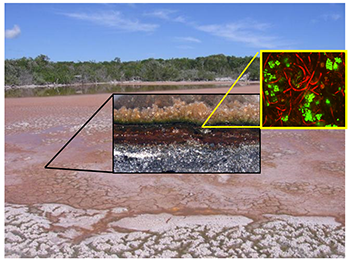Marine bacteria, nanoparticles and health: An unlikely link to fight human infections?
April 28, 2014

Dr. Alan Decho: "Bacteria together communicate with each other in small groups and produce unique antibiotics to inhibit nearby groups. Looking in unique environments for such novel antibiotics may benefit human health down the road."
Antibiotic-resistant bacteria are an emerging crisis in healthcare and community settings. New strains of infectious bacteria develop resistance and take the lives or compromise the health of otherwise healthy humans.
Infections also are the cause of major mortality in people with other conditions, such as AIDS and many cancers, says Dr. Alan Decho, a professor in the Arnold School's Department of Environmental Health Sciences.
In its "Threat Report 2013," the Centers for Disease Control and Prevention raised the alarm to the fact that at least 2 million people become infected with bacteria that are resistant to antibiotics and approximately 23,000 people die each year as a direct result of these infections.
"The antibiotics we use to kill bacteria, however, are actually made by bacteria to inhibit other bacteria," Decho says. "And, it turns out that most antibiotics in use today were derived long ago from just a few kinds of bacteria, which live in soil."
New antibiotics, having novel mechanisms of action, are needed to combat these infections. Yet, pharmaceutical companies are not responding to the challenge, he says.
"The search for novel antibiotics, having novel mechanisms of action, is needed to overcome the growing observed resistance we are seeing," says Decho. "So, we are looking in new places. There are likely new, undiscovered antibiotics having novel mechanisms of action (and perhaps anticancer compounds), being produced by complex microbial communities that we have been studying in other places, for other reasons."
Decho has spent much of his career investigating microbial interactions within biofilms, which are attached bacteria enclosed in a protective matrix. Most bacteria that cause infections occur as biofilms.
As part of this work, he has been researching dense, but very colorful layered groups of natural bacteria called microbial mats in high-salinity ponds in the Bahamas to try and understand how tens of thousands of different kinds of bacterial species can live (productively) in such very-close proximity.
During this work, which has been funded by the National Science Foundation for over 17 years, Decho began to realize that bacteria are ‘talking’ to each other and coordinating their activities using chemical signaling, a process called "quorum sensing."
"Just like people, when bacteria talk to each other and work together, they become more productive and efficient," he says. "This cooperation occurs abundantly in microbial mats. But bacteria within a group also try to inhibit other (outsider) bacteria from coming in. Thus, bacterial interactions going on in these complex microbial mats result in unique natural compounds, such as novel antibiotics, being produced that could not even be conceived in conventional chemistry labs"
During the teaching of his "Microbial Biofilm" class, Decho and graduate students quickly realized that this same bacterial talking (quorum sensing) and inhibition (antibiotic production) relates to human infections.
"We are building an excellent working group of faculty in the Department of Environmental Health Sciences to tackle different aspects of this work," says Decho.
The group includes Drs. Sean Norman, Anindya Chanda, Jamie Lead and Mohammed Balousha, along with a cadre of excited graduate students and tech people who provide "a running tap of ideas."
"It’s a thrill to see excitement and drive in the eyes of our departmental graduate students; it’s one step that’s crucial to building an excellent program and department," Decho says.
Several years ago, Decho and colleagues in the Department of Chemistry and Biochemistry also realized that new antibiotics can be combined with nanotechnology. He teamed up with Drs. Brian Benicewicz, Chuanbing Tang and John Ferry from that department to conduct research on the use of nanotechnology to carry and more-efficiently deliver antibiotics to bacterial cells.
"This involves linking antibiotics to engineered nanoparticles, which are engineered molecule by molecule and are much smaller than the bacteria themselves. When antibiotics are carried by nanoparticles, they (antibiotics) form powerful packets of destruction and more effectively kill antibiotic-resistant bacteria," Decho says.
"This offers interesting therapeutic potential for infection treatment down the road. Now we are looking to make current antibiotics, such as penicillin, more efficient in controlling infections by using nanotechnology, in addition to developing unique antibiotics from microbial mat bacteria and fungi.
"We are even trying to use nanoparticles to shut down the 'talking' and group behavior (quorum sensing) that bacteria use during the infection process to make them weaker and more susceptible to antibiotic treatment," he says.
When Decho first joined USC, his interest centered on bacteria in oceans, and his colleagues mildly derided this decision to join a "school of public health."
Decho admits, "I quietly pondered the same question. However, the link between the environment and health was just beginning to be appreciated in science circles.
"Fortunately, the Deans whom I have had the privilege to work with, beginning with Winona Vernberg, to Harris Pastides, now USC's President, to our current Dean Tom Chandler, have always been forward-thinking and supportive of taking calculated risks in research.
But how did Decho initially make the connection among marine bacteria, nanotechnology and health?
"As I tell the newer faculty in our department, 'If you carefully follow your nose, and build upon the existing faculty strengths around you, exciting connections will abound.'
"And as we say in microbiology, 'we’re making excellent progress, but still have some bugs to work out,' " Decho says.
Working out "those bugs" could prove to be the solution to saving the many lives lost to antibiotic-resistant bacteria.



_01.jpg)
_02.jpg)